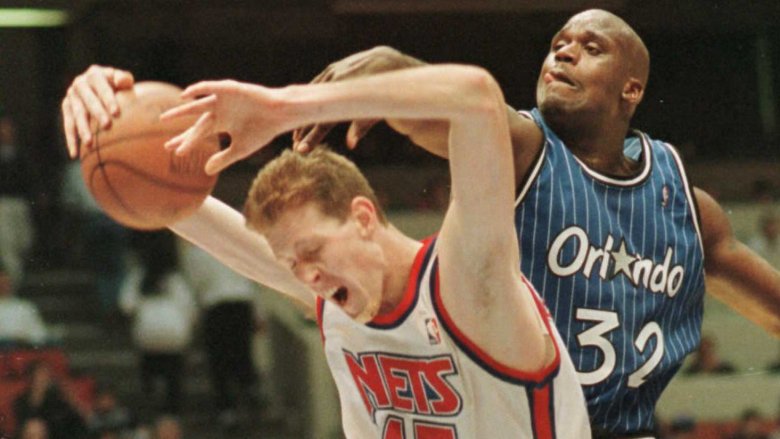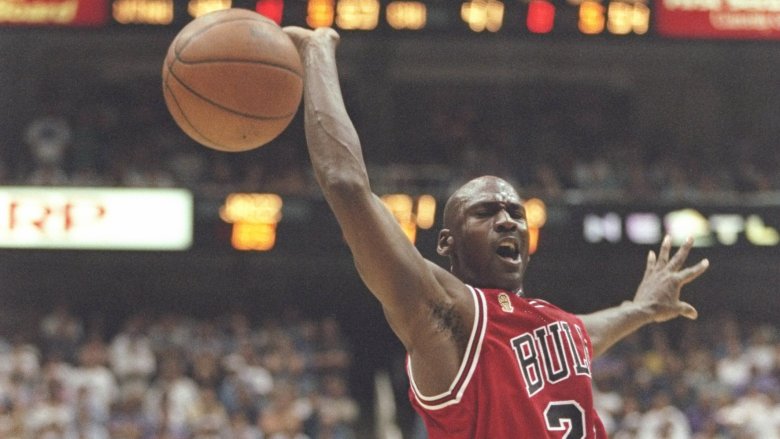False Facts About The NBA You Always Thought Were True
Basketball is one of the most exciting sports in the world, and the NBA offers the highest and most exciting level of play. It's the players, the stories, the unforgettable moments of athletic brilliance, and the fun of it all that keeps fans coming back year after year. After more than seven decades of existence, a great deal of lore and legend has grown up around the NBA, which has led to a number of misconceptions. Here then are some common beliefs, myths, and assumed truths about the league...busted.
Trying to distract free throw shooters actually messes them up
There's a reason they call them "free throws." Okay, it's because the players get to a take a shot "free" from defender, but it could just as well mean "free" as in "free points," because they're typically so easy to make. This means somebody's got to do something to mess up the opposing team while they take their free throws, right?
Fans sitting behind the opponent's basket scream, shout, and wave their arms or objects to psych out the free throw shooter. It's a fun ritual...but it doesn't really do any good. The brain processes motion in such a way that it can easily focus on a fixed point — say, a basketball hoop — and block out the nonsense of the other team's fans throwing their arms in the air.
"Fans might think they're doing something by crazily waving their ThunderStix," neuroscientist Daniel Engber told The New York Times in 2005, referring to those big, noisy balloons fans wave around, "but to the players it's all just a sea of visual white noise."
However, Engber worked with the Dallas Mavericks to devise an audience-based free throw defense he found that if the crowd waved their ThunderStix in unison, it could trick a player's mind "into thinking that he himself is moving, thereby throwing off his shooting." Engber's theory was put into practice in a game against Boston, and the Celtics' free-throw shooting was off by 20 percent.
The Bulls would've kept winning if Jordan stayed
The '90s-era Chicago Bulls reached legendary status when they "three-peated" — winning three titles in a row — twice. Led by Michael Jordan, the Bulls won it all from 1991 to 1993, and from 1996 to 1998. The missing titles in 1994 and 1995 coincided with Jordan briefly retiring from basketball to try pro baseball.
But then, before the 1999 season started, Jordan re-retired. Bulls fans salivate at what could have been — how the Bulls could've kept winning title after title. Except that, in all likelihood, 1998 was the end of an era.
Jordan retired at 36, kinda old for an NBA player. His stats also started slipping, and when he returned to the NBA again in 2001 for the Washington Wizards, his points-per-game average was the lowest of his career.
The Bulls' other big stars, Scottie Pippen and Dennis Rodman, were in the waning years of their careers, too. Pippen played in fewer games per season and scored fewer and fewer points until he retired in 2004; Rodman would play in just 35 games after Jordan's retirement. What the Bulls would've needed to keep contending were exciting young players, and they just didn't have them.
The 1998-99 Bulls had rookies like Corey Benjamin, Cory Carr, Kornel David, and Charles Jones. None of them played more than four seasons in the NBA or amassing a lifetime points-per-game average above 5.5.
The Trail Blazers screwed up on Michael Jordan draft
On paper, it looks like one of the dumbest decision in the history of professional sports. In the 1984 NBA Draft, the Portland Trail Blazers had the #2 pick. The Blazers nabbed University of Kentucky center Sam Bowie. Bowie's stats were impressive: he'd averaged 17.4 points a game his sophomore season, though that fell to 10.5 by his final year, with his college career plagued by injuries.
The Blazers didn't care — they needed a center, and Bowie seemed to be among the best available. However, the Blazers missed out on the player that was selected immediately after Bowie. With the #3 pick, the Chicago Bulls took University of North Carolina shooting guard Michael Jordan. The rest, of course, was history. But did the Blazers actually choose wrong?
No one could predict that Jordan would become the best basketball player who ever lived. Besides, the Blazers already had a young, promising shooting guard by the name of Clyde Drexler. Like Jordan, he appeared on the 1992 Olympic "Dream Team" and is in the Naismith Memorial Basketball Hall of Fame. In 1990, the Blazers reached the NBA Finals thanks to big numbers from Drexler and the guy who'd eventually become the solid center Portland needed, Kevin Duckworth. That means Drexler and the Blazers beat Jordan and the Bulls to the NBA finals by a year. Not such a bad choice after all.
Jay Z owns the Brooklyn Nets
It seems like Jay Z has everything. Mad flow. Platinum records. Millions of dollars. Beyoncé. He even owns the Brooklyn Nets! Except that's one of the few things Jay Z actually doesn't have.
Hov is an extremely wealthy musician and entrepreneur, but professional sports franchises are too rich even for his blood. At one point, Jay Z owned just one-fifteenth of 1 percent of the Nets, for which his buy-in was reportedly a relatively paltry $1 million. Jay Z sold his share in 2013, and while he no longer owns a piece of the team, he does have a piece of the place where it plays. The Brooklyn Nets take the court at Barclays Arena, of which Jay Z owns one-fifth of 1 percent.
The Orlando Magic are named after Disney
The Orlando Magic hit the court in 1989, the first major American pro-sports franchise in the Orlando area, which grew exponentially since 1971 with the opening of Walt Disney World. The jewel of the resort is the amusement park's Magic Kingdom. When Orlando got its team, "Magic" was a perfectly logical and geographically appropriate name — as opposed to, say, how the Lakers kept its name after moving to LA from Minnesota, "the land of 10,000 lakes."
But the Orlando Magic aren't named after Disney's theme park. According to the NBA, Orlando businessman Jim Hewitt and ex-Philadelphia 76ers GM Pat Williams met in the mid-1980s about bringing a basketball team to Orlando. They figured the city would look more attractive to the league if they'd already picked a name. So, the duo got the Orlando Sentinel to hold a "name the team" contest.
After receiving over 4,000 entries, a committee narrowed the choices to the Tropics, the Juice, the Heat (the Miami Heat didn't exist yet), and the Magic. Before the committee made its decision, Williams' seven-year-old daughter, Karyn, came down for a visit. As she boarded her plane at the trip's end, she reflected on her experience in Orlando. "I really like this place," she said. "This place is like magic."
Williams made sure the committee took Karyn's comment into consideration. And it's the idea that ultimately won when Orlando officially got its NBA franchise in 1987.
Michael Jordan had the flu during "The Flu Game"
In a career full of remarkable moments, "The Flu Game" is one of the standouts for Michael Jordan. With the 1997 Finals tied at two between the Chicago Bulls and Utah Jazz, Game 5 was crucial. Jordan came through, leading all scorers with 38 points. Final Score: Bulls 90, Jazz 88.
After the game, Jordan told reporters he'd been feeling "really tired and very weak," and that he played until he almost passed out, ignoring low energy, dehydration, and difficulty breathing. Clearly, Jordan was very sick, and his symptoms pointed to the flu, hence the game going down in history as "The Flu Game."
But Tim Grover, Jordan's personal trainer at the time, blames another culprit: food poisoning. In 2013, Grover told TrueHoop TV that late at night before Game 5, Jordan got hungry in his Park City, Utah, hotel room, and they ordered a pizza. When it arrived, it was delivered by not one, but five guys.
Basketball fans who wanted a glimpse at Jordan? Or Jazz fans looking to sabotage the other team's chances? As he took the pizza, Grover recalls feeling very suspicious. He said only Jordan ate the pizza, and only Jordan was up at 2 a.m. "curled up in the fetal position." As far as Grover was concerned, that indicated somebody did something to that pizza. Bulls teammate Ron Harper shared Grover's suspicions.
Kobe Bryant was always a Laker
In a league in which free agency rules everything, where big-market or big-money teams can score the best players, it seems like nobody plays their whole career with one team anymore. Gone are the days of the "franchise player" who only ever wore one uniform — Larry Bird with the Celtics, or John Stockton with the Jazz, for example.
Kobe Bryant was a contemporary throwback to those good old days, never taking the floor in his historic NBA career in anything other than the purple-and-gold of a Los Angeles Lakers jersey. From his rookie year in 1996 to his retirement 20 years later, Bryant was always a Laker. Well, technically, yes. Bryant played for the Lakers the whole time, but he was drafted in 1996 by the Charlotte Hornets. He was selected with the relatively low #13 pick, and then immediately sent to the Lakers.
Wilt Chamberlain's 100-point game was a singular athletic achievement
On March 2, 1962, the Philadelphia Warriors hosted the New York Knicks and beat them 169 to 147. Wilt Chamberlain led all scorers, with a record-setting 100 points. It's certainly an impressive feat. But with more context, the lofty legend falls a bit closer to earth.
For example, the Warriors were a playoff-bound elite team, and the Knicks were comfortably at the bottom of the Eastern Division standings. It was likely the Warriors would crush the Knicks anyway, especially since they lacked starter Phil Jordan, who was officially out with the flu, but whom teammates suspected was hungover. The Knicks could only offer up a series of defenders much smaller than Chamberlain, enabling him to easily rack up a ridiculous 41 points by halftime, according to the LA Times.
Even into the third quarter, few fans in Hershey Arena thought too much of Chamberlain's stats, as the scoreboard in the facility didn't display individual player totals. But Harvey Pollack — the Warriors publicity director, was keeping track, and he asked the arena's announcer to let the fans know what was going on. Suddenly Warriors fans and players all seemed to share the same goal: to see how far Chamberlain could go. He was given the ball often, taking a whopping 63 shots in all. Plus, he got in a lot of free throws, being frequently fouled by the Knicks. All of that cleared the path for Chamberlain to hit triple digits.







